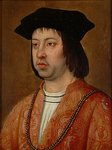Ferdinand II of Aragon
en.wikipedia.org
Ferdinand II of Aragon

There was no imperial ‘grand strategy’ to make Spain the centre of a world economy: indeed, such a plan would have been futile. Instead, Philip II devoted the ‘royal fifth’ – the monarchy’s share of the silver stream – to the struggle to uphold Spain’s pre-eminence in Europe against rivals and rebels.